Question Bank
Question-1: If


 =
=  =
=  = ½
= ½
Hence the limit of the sequence is 1/2 .
Question-2: check whether the series  is convergent or divergent. Find its value in case of convergent.
is convergent or divergent. Find its value in case of convergent.
Sol. As we know that,
Sn = 
Therefore,
Sn = 
Now find out the limit of the sequence,
 = ∞
= ∞
Here the value of the limit is infinity, so that the series is divergent as sequence diverges.
Question-3: check whether the series  is convergent or divergent.
is convergent or divergent.
Sol. The general formula can be written as,

We get on applying limits,
 ) = 3/4
) = 3/4
This is the convergent series and its value is 3 / 4
Question-4: Test the convergence of the following series.

Sol. We have 
First we will find  and the
and the 


And
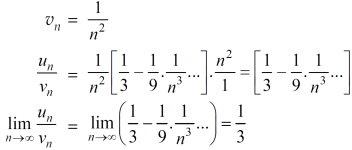
Here, we can see that, the limit is finite and not zero,
Therefore,  and
and  converges or diverges together.
converges or diverges together.
Since  is of the form
is of the form  where p = 2>1
where p = 2>1
So that , we can say that,
 is convergent , so that
is convergent , so that  will also be convergent.
will also be convergent.
Question-5: Test the convergence of the following series-

Sol. Here we have the series,

Now,


Now comapare 


We can see that the limit is finite and not zero.
Here  and
and  converges or diverges together since ,
converges or diverges together since ,
 is the form of
is the form of  here p = 1,
here p = 1,
So that,
 is divergent then
is divergent then  is also divergent.
is also divergent.
Question-6: Show that the following series is convergent.

Sol.


Suppose,
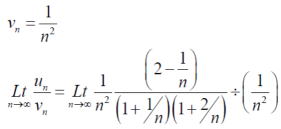

Which is finite and not zero.
By comparison test  and
and  converge or diverge together.
converge or diverge together.
But,

Is convergent. So that  is also convergent.
is also convergent.
Question-7: Test the convergence of the following series:

Sol.
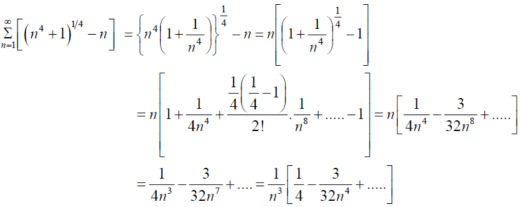
Here we take,


Which not zero and finite ,
So by comparison test ,  and
and  both converges or diverges, but by p-series test
both converges or diverges, but by p-series test

Is convergent . So that  is convergent.
is convergent.
Question-8: Test the convergence of the following series:

Sol.

Here we take,


Which not zero and finite ,
So by comparison test ,  and
and  both converges or diverges, but by p-series test
both converges or diverges, but by p-series test

Is convergent . So that  is convergent.
is convergent.
Question-9: Test for the convergence of the n’th term of the series given below-

Sol. We have ,



Now , by D’Almbert ratio test  converges if
converges if  and diverges if
and diverges if 
At x = 1 , this test fails.
Now , when x = 1
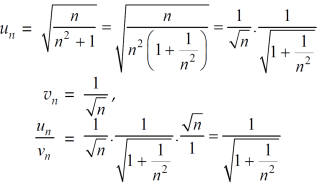

The limit is finite and not zero.
Then by comparison test,  converges or diverges together.
converges or diverges together.
Since  is the form of
is the form of  , in which
, in which 
Hence  diverges then
diverges then  will also diverge.
will also diverge.
Therefore in the given series  converges if x<1 and diverges if x≥1.
converges if x<1 and diverges if x≥1.
Question-10: Test the convergence of the series,

Sol. As we will neglect the first term, we get

By ration test  is convergent when x<1 and divergent when x>1, when x= 1,
is convergent when x<1 and divergent when x>1, when x= 1,
The rario test fails, then

By Rabee’s test  is convergent , hence the given series is convergent when x≤ 1 and divergent If x >1.
is convergent , hence the given series is convergent when x≤ 1 and divergent If x >1.
Question-11: Test the nature of the following series:

Sol.
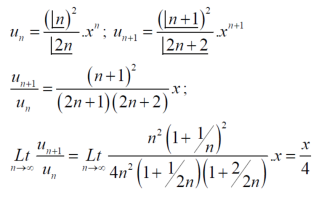
By ration test  is convergent when (x/4)<1 and divergent when x>4, when x= 4,
is convergent when (x/4)<1 and divergent when x>4, when x= 4,
The rario test fails, then

By Rabee’s test  is convergent , hence the given series is convergent when x<4 and divergent If x >=4.
is convergent , hence the given series is convergent when x<4 and divergent If x >=4.
Question-12: Test the series by integral test- 
Sol. Here  is positive and decreases when we increase n ,
is positive and decreases when we increase n ,
Now apply integral test,

Let,

X = 1 , t = 5 and x = ∞ , t = ∞,
Now,

So by integral test,
The series is divergent.
Question-13: Test the convergence of the following series:

Sol. Here, we have,




Therefore the given series is convergent.
Question-14: Test the convergence of the following series:

Sol. We have the series,

Here ,  And
And 



Which gives,

 , the series is convergent.
, the series is convergent.
If  , the series is divergent.
, the series is divergent.
 .
.



Thus the series is divergent.
Question-15: Test the convergence of the following alternating series:

Sol. Here in the series, we have


First condition-


So that,
| | > |
| > | |
|
That means , each term is not numerically less than its preceeding terms.
Now second condition-

Both conditions are not satisfied for convergence.
Hence the given series is not convergent. It is oscillatory.
Question-16: Test the following series for the convergence-

Sol. We have the given series, now

We see that, this is an alternating series,
Here,
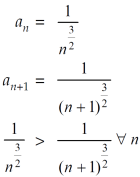
Also,

By Leibinitz’s test the series is convergent.
Question-17: Test the convergence/Divergence of the series:

Sol. Here the given series is alternately negative and positive , which is also a geometric infinite series.
1. Suppose,
S = 
According to the conditions of geometric series,
Here , a = 5 , and common ratio (r) = -2/3
Thus, we know that,

So , 
Sum of the series is finite , which is 3.
So we can say that the given series is convergent.
Now.
Again sum of the positive terms,

The series is geometric, then
A = 5 and r = 2/3 , then
Sum of the series,

Sum of the series is finite then the series is convergent.
Both conditions are satisfied , then the given series is absolutely convergent
Question Bank
Question Bank
Question-1: If


 =
=  =
=  = ½
= ½
Hence the limit of the sequence is 1/2 .
Question-2: check whether the series  is convergent or divergent. Find its value in case of convergent.
is convergent or divergent. Find its value in case of convergent.
Sol. As we know that,
Sn = 
Therefore,
Sn = 
Now find out the limit of the sequence,
 = ∞
= ∞
Here the value of the limit is infinity, so that the series is divergent as sequence diverges.
Question-3: check whether the series  is convergent or divergent.
is convergent or divergent.
Sol. The general formula can be written as,

We get on applying limits,
 ) = 3/4
) = 3/4
This is the convergent series and its value is 3 / 4
Question-4: Test the convergence of the following series.

Sol. We have 
First we will find  and the
and the 


And

Here, we can see that, the limit is finite and not zero,
Therefore,  and
and  converges or diverges together.
converges or diverges together.
Since  is of the form
is of the form  where p = 2>1
where p = 2>1
So that , we can say that,
 is convergent , so that
is convergent , so that  will also be convergent.
will also be convergent.
Question-5: Test the convergence of the following series-

Sol. Here we have the series,

Now,


Now comapare 


We can see that the limit is finite and not zero.
Here  and
and  converges or diverges together since ,
converges or diverges together since ,
 is the form of
is the form of  here p = 1,
here p = 1,
So that,
 is divergent then
is divergent then  is also divergent.
is also divergent.
Question-6: Show that the following series is convergent.

Sol.


Suppose,
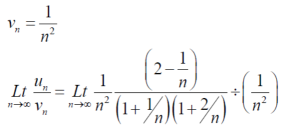

Which is finite and not zero.
By comparison test  and
and  converge or diverge together.
converge or diverge together.
But,

Is convergent. So that  is also convergent.
is also convergent.
Question-7: Test the convergence of the following series:

Sol.

Here we take,


Which not zero and finite ,
So by comparison test ,  and
and  both converges or diverges, but by p-series test
both converges or diverges, but by p-series test

Is convergent . So that  is convergent.
is convergent.
Question-8: Test the convergence of the following series:

Sol.
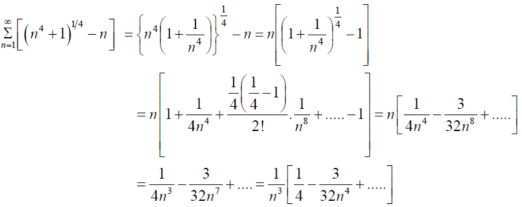
Here we take,


Which not zero and finite ,
So by comparison test ,  and
and  both converges or diverges, but by p-series test
both converges or diverges, but by p-series test

Is convergent . So that  is convergent.
is convergent.
Question-9: Test for the convergence of the n’th term of the series given below-

Sol. We have ,



Now , by D’Almbert ratio test  converges if
converges if  and diverges if
and diverges if 
At x = 1 , this test fails.
Now , when x = 1
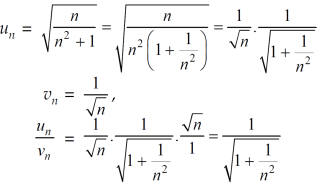

The limit is finite and not zero.
Then by comparison test,  converges or diverges together.
converges or diverges together.
Since  is the form of
is the form of  , in which
, in which 
Hence  diverges then
diverges then  will also diverge.
will also diverge.
Therefore in the given series  converges if x<1 and diverges if x≥1.
converges if x<1 and diverges if x≥1.
Question-10: Test the convergence of the series,

Sol. As we will neglect the first term, we get
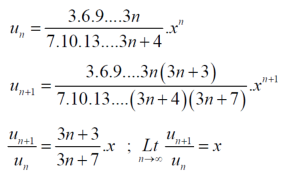
By ration test  is convergent when x<1 and divergent when x>1, when x= 1,
is convergent when x<1 and divergent when x>1, when x= 1,
The rario test fails, then
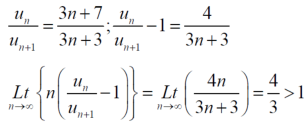
By Rabee’s test  is convergent , hence the given series is convergent when x≤ 1 and divergent If x >1.
is convergent , hence the given series is convergent when x≤ 1 and divergent If x >1.
Question-11: Test the nature of the following series:

Sol.
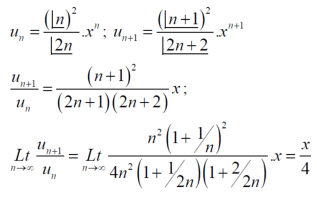
By ration test  is convergent when (x/4)<1 and divergent when x>4, when x= 4,
is convergent when (x/4)<1 and divergent when x>4, when x= 4,
The rario test fails, then

By Rabee’s test  is convergent , hence the given series is convergent when x<4 and divergent If x >=4.
is convergent , hence the given series is convergent when x<4 and divergent If x >=4.
Question-12: Test the series by integral test- 
Sol. Here  is positive and decreases when we increase n ,
is positive and decreases when we increase n ,
Now apply integral test,

Let,

X = 1 , t = 5 and x = ∞ , t = ∞,
Now,

So by integral test,
The series is divergent.
Question-13: Test the convergence of the following series:

Sol. Here, we have,




Therefore the given series is convergent.
Question-14: Test the convergence of the following series:

Sol. We have the series,

Here ,  And
And 



Which gives,

 , the series is convergent.
, the series is convergent.
If  , the series is divergent.
, the series is divergent.
 .
.



Thus the series is divergent.
Question-15: Test the convergence of the following alternating series:

Sol. Here in the series, we have


First condition-


So that,
| | > |
| > | |
|
That means , each term is not numerically less than its preceeding terms.
Now second condition-

Both conditions are not satisfied for convergence.
Hence the given series is not convergent. It is oscillatory.
Question-16: Test the following series for the convergence-

Sol. We have the given series, now

We see that, this is an alternating series,
Here,

Also,

By Leibinitz’s test the series is convergent.
Question-17: Test the convergence/Divergence of the series:

Sol. Here the given series is alternately negative and positive , which is also a geometric infinite series.
1. Suppose,
S = 
According to the conditions of geometric series,
Here , a = 5 , and common ratio (r) = -2/3
Thus, we know that,

So , 
Sum of the series is finite , which is 3.
So we can say that the given series is convergent.
Now.
Again sum of the positive terms,

The series is geometric, then
A = 5 and r = 2/3 , then
Sum of the series,

Sum of the series is finite then the series is convergent.
Both conditions are satisfied , then the given series is absolutely convergent